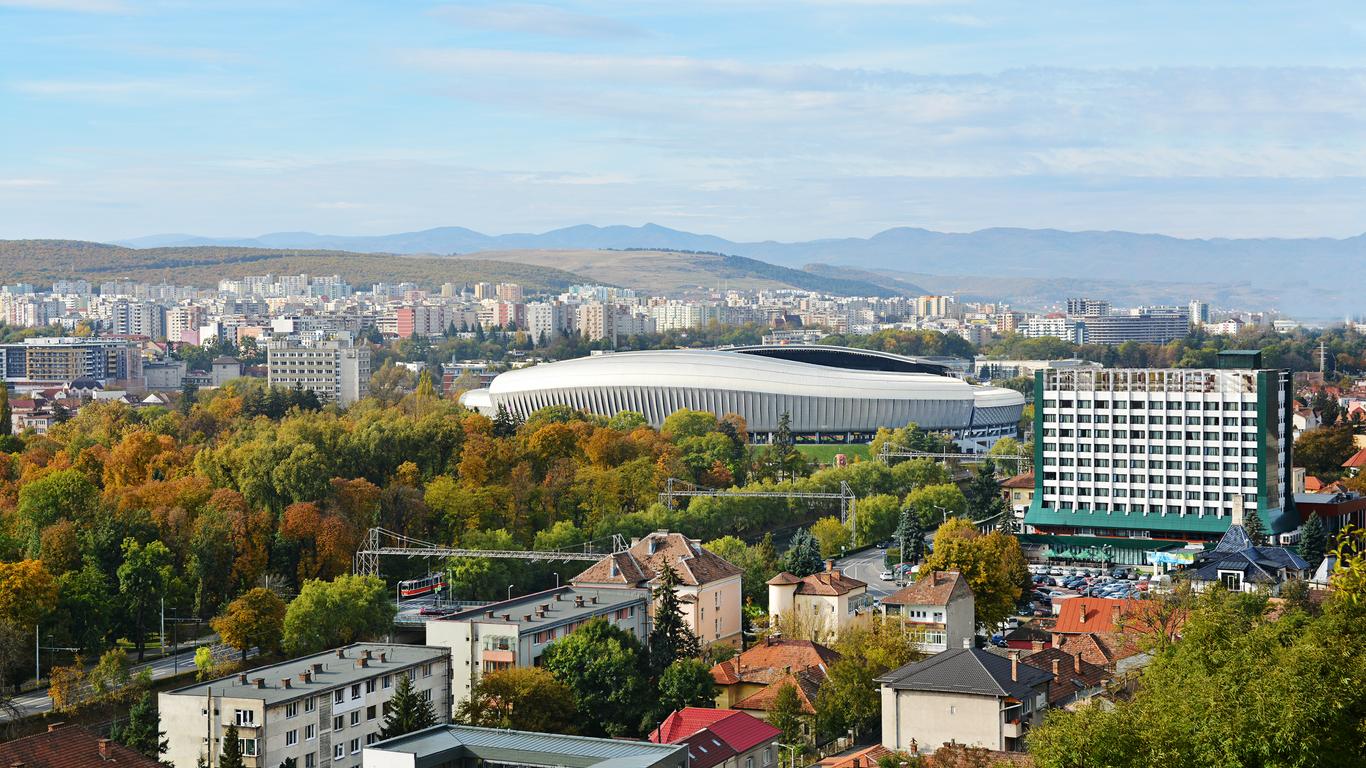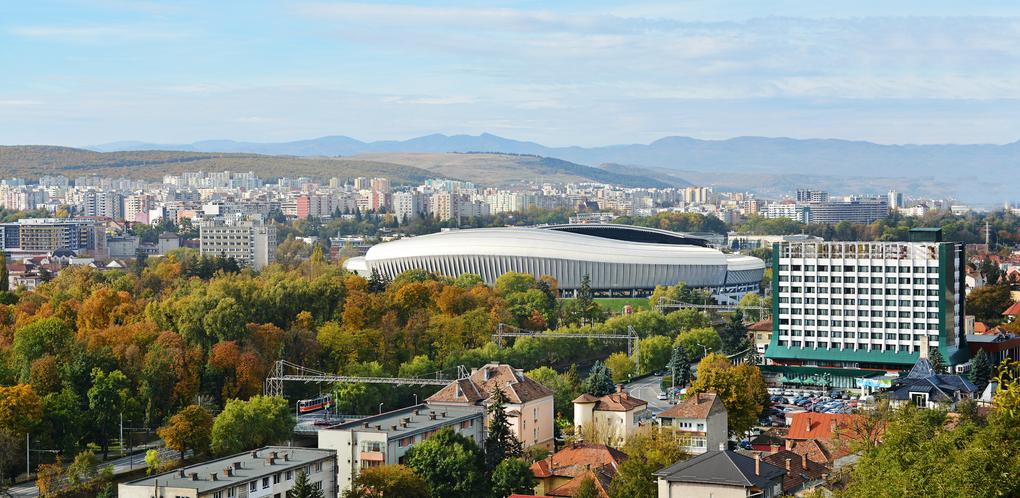
Cluj Napoca travel guide
Cluj Napoca Tourism | Cluj Napoca Guide
You're Going to Love Cluj Napoca
The second largest city in Romania is a cultural melting pot with a lively schedule of music festivals, a charming historic center, all the galleries and museums you could need and a youthful, irrepressible nightlife scene.

Top 5 Reasons to Visit Cluj Napoca
1. The Historic Downtown Area
Cluj Napoca has been the capital of Transylvania for centuries. Historical highlights are plentiful, including the statue of Hungarian king Matthias Corvinus and the Gothic beauty of St. Michael's Church.
2. Plenty of Music Festivals
Cluj Napoca is probably Romania's musical nexus, offering annual events like August's Untold dance festival and Electric Castle in July, which features leading Romanian acts.
3. Easy Access to Transylvania's Countryside
Transylvania is full of wonders (and hardly any vampires, actually). Don't miss Bran Castle, Biertan Church and the therapeutic volcanic spa at Covasna.
4. Museums and Galleries to Keep Anyone Busy
Back in the town, the Banffy Palace houses the superb National Art Museum, the Transylvanian History Museum and the fascinating Pharmacy History Collection.
5. Beautiful City Center Parks and Gardens
Cluj Napoca is green and spacious, with gorgeous attractions like the Alexandru Borza Botanic Gardens and the Romulus Vuia Ethnographic Park, which features reconstructions of medieval buildings.
What to do in Cluj Napoca
1. The Central Meeting Place
The charming cobblestoned streets and warm inviting storefronts make central Museum Square one of the most popular tourist thoroughfares in Cluj-Napoca. During the summer months you can shop at regular open air market stalls which sell fresh produce, local handcrafts, and mouthwatering Romanian delicacies. In the winter months, Museum Square acts as the focal point for one of the best Christmas markets in Transylvania. This high-trafficked section of Cluj-Napoca also features several noteworthy structures on it's perimeter including the Franciscan Monastery, the Transylvanian History Museum, and the old city Obelisk of the city.
2. The Green City Sanctuary
Located in the south of Cluj-Napoca are the stunning Botanical Gardens. The park covers 14 hectares and boasts over 10,000 plants, both foreign and native to the Transylvanian region. Through a series of fairly level walking paths, you can learn about the different species present in the Japanese and Roman gardens while spending a relaxing afternoon away from the downtown city buzz. In 2010 the botanical garden was added to Romania's list of national monuments, further safeguarding its utilitarian use as a teaching and research center through Babeș-Bolyai University, and a popular tourist destination. Travel tip: climb to the top of the observation tower in order to get some of the best views of the Cluj-Napoca Botanical Garden.
3. A Peek Into Romanian Culture
One of the most rewarding parts of traveling to Romania is learning about the local customs and culture. At the Ethnography Museum of Transylvania, located in Reduta Palace, the emphasis is on rural Romanian lifestyles and handcrafts, including tools, clothes, and ceramics. For a deeper look into everyday Romanian village life, head to the accompanying Ethnographic Park in the Hoia Forest. There you can immerse yourself in an open-air setting with many reconstructed farms, churches, and installations dating back to the 17th century.
4. A Class Above The Rest
The Lucian Blaga National Theater is a prestigious concert hall venue in Cluj Napoca which has become renowned throughout Romania for its quality artistic performances and breathtaking architecture. This Neo-Baroque style theater opened in the early 20th century when the region was still part of the Hungarian empire. Today it offers performances of Shakespeare, Kafka, and Molière alongside regional Romanian legends like Vasile Alecsandri. The National Theater shares the same building with the Romanian Opera, making it a central point of high culture performances in Cluj-Napoca.
5. The City's Stronghold
Originally built in the 15th century, Tailor's Bastion was once part of a larger defensive fortress which protected the city from invaders. Located in the southeast corner of the Cluj-Napoca citadel,the Bastion gets its name for the artisans who once guarded and maintained the old city wall. After several changes in regime, the site fell into disrepair and was largely abandoned until 2007. After years of re-purposing, the Bastion now serves as a Center for Urban Culture with art galleries, open exhibition spaces, and conference halls available for public education.
1. The Central Meeting Place
The charming cobblestoned streets and warm inviting storefronts make central Museum Square one of the most popular tourist thoroughfares in Cluj-Napoca. During the summer months you can shop at regular open air market stalls which sell fresh produce, local handcrafts, and mouthwatering Romanian delicacies. In the winter months, Museum Square acts as the focal point for one of the best Christmas markets in Transylvania. This high-trafficked section of Cluj-Napoca also features several noteworthy structures on it's perimeter including the Franciscan Monastery, the Transylvanian History Museum, and the old city Obelisk of the city.
2. The Green City Sanctuary
Located in the south of Cluj-Napoca are the stunning Botanical Gardens. The park covers 14 hectares and boasts over 10,000 plants, both foreign and native to the Transylvanian region. Through a series of fairly level walking paths, you can learn about the different species present in the Japanese and Roman gardens while spending a relaxing afternoon away from the downtown city buzz. In 2010 the botanical garden was added to Romania's list of national monuments, further safeguarding its utilitarian use as a teaching and research center through Babeș-Bolyai University, and a popular tourist destination. Travel tip: climb to the top of the observation tower in order to get some of the best views of the Cluj-Napoca Botanical Garden.
3. A Peek Into Romanian Culture
One of the most rewarding parts of traveling to Romania is learning about the local customs and culture. At the Ethnography Museum of Transylvania, located in Reduta Palace, the emphasis is on rural Romanian lifestyles and handcrafts, including tools, clothes, and ceramics. For a deeper look into everyday Romanian village life, head to the accompanying Ethnographic Park in the Hoia Forest. There you can immerse yourself in an open-air setting with many reconstructed farms, churches, and installations dating back to the 17th century.
4. A Class Above The Rest
The Lucian Blaga National Theater is a prestigious concert hall venue in Cluj Napoca which has become renowned throughout Romania for its quality artistic performances and breathtaking architecture. This Neo-Baroque style theater opened in the early 20th century when the region was still part of the Hungarian empire. Today it offers performances of Shakespeare, Kafka, and Molière alongside regional Romanian legends like Vasile Alecsandri. The National Theater shares the same building with the Romanian Opera, making it a central point of high culture performances in Cluj-Napoca.
5. The City's Stronghold
Originally built in the 15th century, Tailor's Bastion was once part of a larger defensive fortress which protected the city from invaders. Located in the southeast corner of the Cluj-Napoca citadel,the Bastion gets its name for the artisans who once guarded and maintained the old city wall. After several changes in regime, the site fell into disrepair and was largely abandoned until 2007. After years of re-purposing, the Bastion now serves as a Center for Urban Culture with art galleries, open exhibition spaces, and conference halls available for public education.
Where to Eat in Cluj Napoca
Cluj Napoca has some fantastic dining options, from the fish specialties at Baracca to gourmet sushi at Tokyo Restaurant, and classical Transylvanian fare at Casa Ardeleana (check out the soup served in hollowed out loaves). Meals start at around RON15-20.
When to visit Cluj Napoca
If you want to attend a music festival, summer (June through September) is the time to go. However, spring and fall are fine seasons to explore Transylvania as well.
How to Get to Cluj Napoca
Plane
Cluj-Napoca International Airport has good European connections. From there, bus number 5 costs RON4 and taxis cost about RON20.
Train
There are InterCity rail connections to Bucharest and other Romanian cities. It's about an 8 hour journey from the capital.
Car
From Bucharest, you can follow the E81 all the way to Cluj Napoca. From Timisoara, take the A1 eastbound, then change to the E81 at Sebes.
Bus
EuroBusWays, OrangeWays and Royal GTS run buses from Budapest and Bucharest.
Airlines serving Cluj Napoca
Where to stay in Cluj Napoca
Centru - Cluj Napoca's old town Centru is packed with cafés, galleries and, most of all, beautiful churches.
Popular Neighborhoods in Cluj Napoca
Mănăștur - A sprawling residential area, Mănăștur hosts some of the city's best eateries, including Casa Piraților and Valahia.
Zorilor - Located in the southern half of the city, Zorilor is a thriving student area, with plenty of clubs and bars to pick from.
Where to stay in popular areas of Cluj Napoca
Most booked hotels in Cluj Napoca
How to Get Around Cluj Napoca
The Cost of Living in Cluj Napoca
Shopping Streets
If you want to shop for bargain apparel, head to huge city center malls like Lulius Mall, Galeriile Ferdinand or the Polus Center, or explore the streets around Mihai Viteazu Square.
Groceries and Other
Supermarkets include Kaufland and Billa, where you'll pay about RON15 for a gallon of milk.
